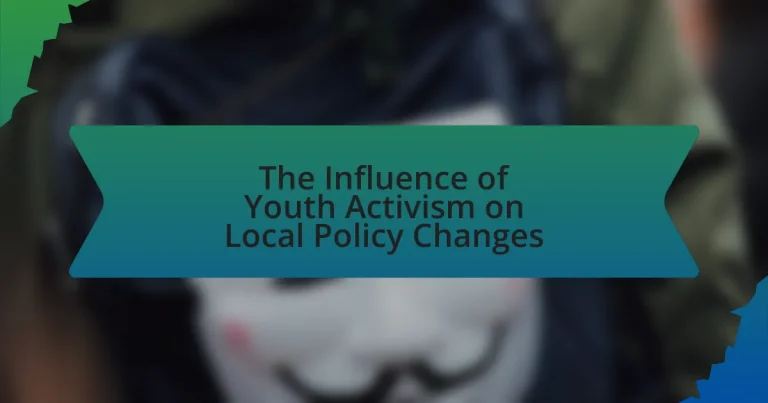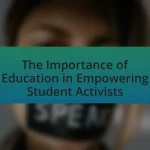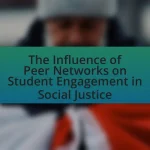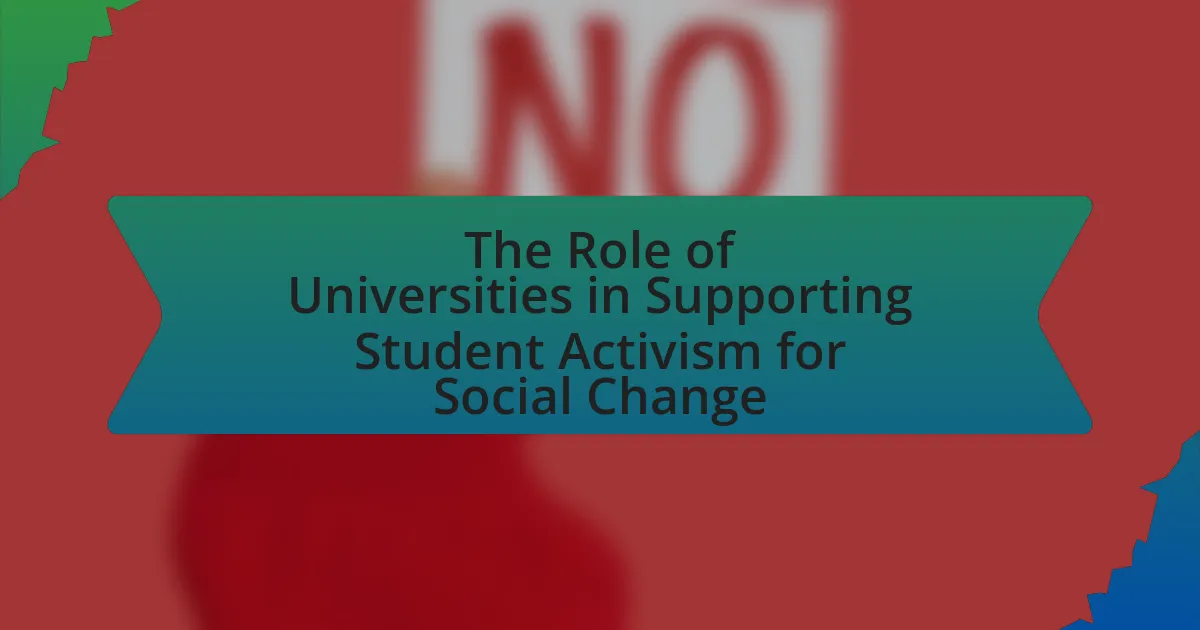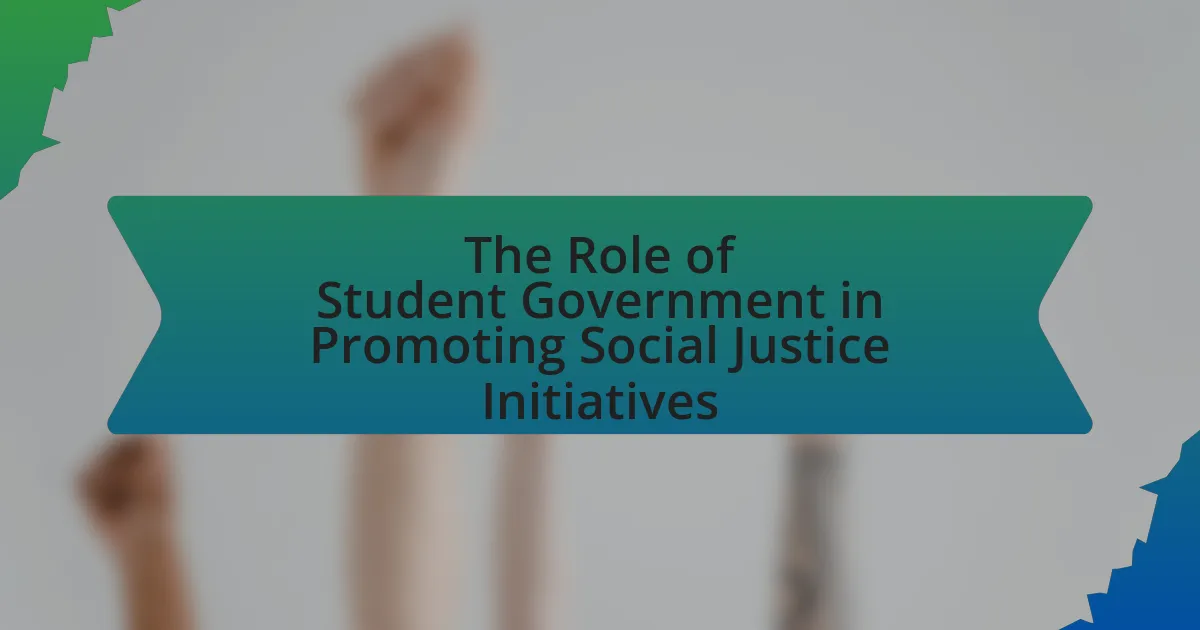Youth activism plays a crucial role in influencing local policy changes by mobilizing young individuals to advocate for pressing issues such as climate action, education reform, and social justice. The article examines how organized movements, like March for Our Lives and the Sunrise Movement, have successfully prompted legislative changes and increased youth engagement in local governance. It highlights the various forms of youth activism, including protests and social media campaigns, and discusses the mechanisms through which these efforts impact policy discussions. Additionally, the article addresses the challenges youth activists face, such as institutional barriers and socioeconomic factors, while emphasizing the importance of mentorship, education, and community engagement in enhancing their influence on local policies.
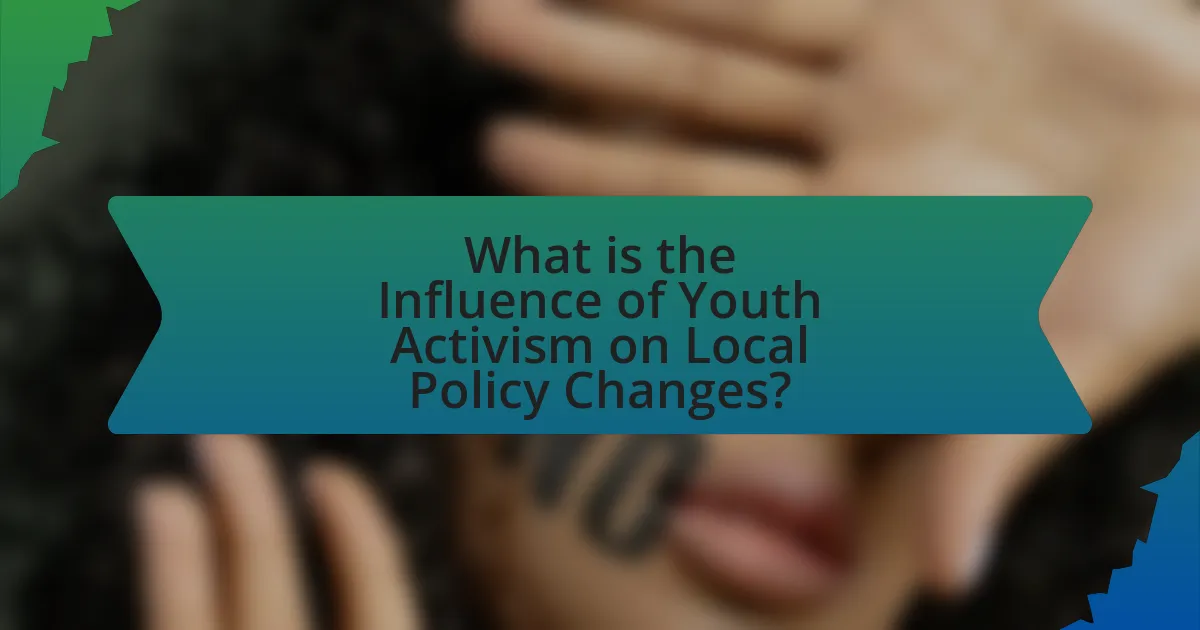
What is the Influence of Youth Activism on Local Policy Changes?
Youth activism significantly influences local policy changes by mobilizing young people to advocate for issues such as climate action, education reform, and social justice. For instance, the youth-led March for Our Lives movement successfully pushed for stricter gun control measures in various states following the Parkland shooting in 2018, demonstrating how organized youth efforts can lead to legislative changes. Additionally, studies show that local governments often respond to youth activism by engaging in dialogue and implementing policies that reflect the concerns raised by young activists, as seen in cities that have adopted youth councils to incorporate young voices in decision-making processes.
How does youth activism manifest in local communities?
Youth activism manifests in local communities through organized movements, advocacy campaigns, and participation in civic engagement initiatives. These activities often focus on issues such as climate change, social justice, and education reform, where young people mobilize to raise awareness and influence local policies. For instance, the Sunrise Movement, which emphasizes climate action, has successfully engaged youth in grassroots organizing, leading to local policy proposals aimed at sustainability. Additionally, youth-led initiatives like school walkouts for gun control have demonstrated the power of collective action, resulting in increased dialogue around legislative changes at the local level. Such activism not only empowers young individuals but also fosters community solidarity and drives significant policy discussions.
What are the common forms of youth activism?
Common forms of youth activism include protests, social media campaigns, community organizing, and advocacy through educational initiatives. Protests, such as climate strikes led by youth, mobilize large groups to demand policy changes, exemplified by the global Fridays for Future movement initiated by Greta Thunberg. Social media campaigns leverage platforms like Instagram and Twitter to raise awareness and mobilize support, as seen in movements like Black Lives Matter, which gained significant traction among younger demographics. Community organizing involves grassroots efforts to address local issues, often resulting in direct engagement with policymakers. Educational initiatives, such as workshops and seminars, empower youth with knowledge about civic engagement and policy processes, fostering informed activism. These forms collectively demonstrate the active role of youth in influencing local policy changes.
How do these forms impact local engagement?
Youth activism significantly enhances local engagement by mobilizing community members around specific issues, fostering a sense of ownership and responsibility. This engagement is evidenced by increased participation in local governance, as seen in various youth-led initiatives that have successfully influenced policy decisions, such as climate action plans and educational reforms. For instance, the Sunrise Movement has effectively organized youth to advocate for the Green New Deal, resulting in heightened awareness and involvement in local environmental policies. Such activism not only amplifies youth voices but also encourages diverse community participation, leading to more representative and responsive local governance.
Why is youth activism important for local policy changes?
Youth activism is important for local policy changes because it empowers young individuals to influence decision-making processes that affect their communities. Engaged youth bring fresh perspectives and innovative solutions to pressing issues, often highlighting concerns that may be overlooked by traditional policymakers. For instance, studies have shown that youth-led movements, such as those advocating for climate action, have successfully prompted local governments to adopt more sustainable practices and policies. The 2019 Global Climate Strike, led by youth activists, resulted in numerous municipalities declaring climate emergencies and committing to more aggressive environmental policies. This demonstrates that youth activism not only raises awareness but also drives tangible policy shifts at the local level.
What historical context supports the rise of youth activism?
The historical context supporting the rise of youth activism includes significant social movements and political events that have empowered young people to advocate for change. For instance, the civil rights movement of the 1960s saw youth play a crucial role in protests and advocacy, exemplified by the involvement of students in the Student Nonviolent Coordinating Committee (SNCC). Additionally, the anti-Vietnam War protests in the late 1960s mobilized young people across the United States, highlighting their capacity to influence public opinion and policy. The emergence of digital communication in the 21st century further amplified youth voices, enabling rapid organization and dissemination of information, as seen in movements like the March for Our Lives and climate strikes initiated by young activists like Greta Thunberg. These historical events illustrate how youth activism has evolved and gained momentum, driven by a combination of social injustice, political disenfranchisement, and technological advancements.
How does youth activism challenge traditional political structures?
Youth activism challenges traditional political structures by mobilizing young people to advocate for social change, often bypassing established political channels. This generation utilizes digital platforms to organize protests, raise awareness, and influence public opinion, which disrupts conventional political processes. For instance, movements like March for Our Lives and Fridays for Future have demonstrated significant impact by directly engaging with policymakers and leveraging social media to amplify their messages, leading to policy discussions on gun control and climate change. These actions illustrate how youth activism not only questions the status quo but also demands accountability from political leaders, thereby reshaping the political landscape.
What role do social media and technology play in youth activism?
Social media and technology serve as crucial tools for youth activism by facilitating communication, mobilization, and awareness-raising among young people. These platforms enable activists to share information rapidly, organize events, and connect with like-minded individuals across geographical boundaries. For instance, the use of Twitter and Instagram has been instrumental in movements such as Black Lives Matter, where hashtags and viral posts have galvanized support and prompted discussions on systemic racism. Research from the Pew Research Center indicates that 72% of teens use social media, highlighting its significance as a primary means of engagement for this demographic. Additionally, technology allows for the creation of online petitions and crowdfunding campaigns, further empowering youth to influence local policy changes effectively.
How do digital platforms facilitate youth mobilization?
Digital platforms facilitate youth mobilization by providing accessible communication channels that enable rapid information sharing and organization of collective actions. These platforms, such as social media and messaging apps, allow young people to connect, collaborate, and mobilize around shared causes, significantly increasing their reach and impact. For instance, during the 2019 climate strikes, platforms like Twitter and Instagram were instrumental in organizing global protests, with millions of participants mobilized through hashtags and event pages. This demonstrates that digital platforms not only enhance visibility for youth-led initiatives but also empower young activists to coordinate efforts effectively, leading to tangible local policy changes.
What are the risks and benefits of online activism?
Online activism presents both significant risks and benefits. The primary benefit is its ability to mobilize large groups quickly, raising awareness and driving social change, as evidenced by movements like Black Lives Matter, which gained global traction through social media platforms. Conversely, a notable risk is the potential for misinformation to spread rapidly, undermining the credibility of movements and leading to public confusion, as seen during various political campaigns where false narratives proliferated online.
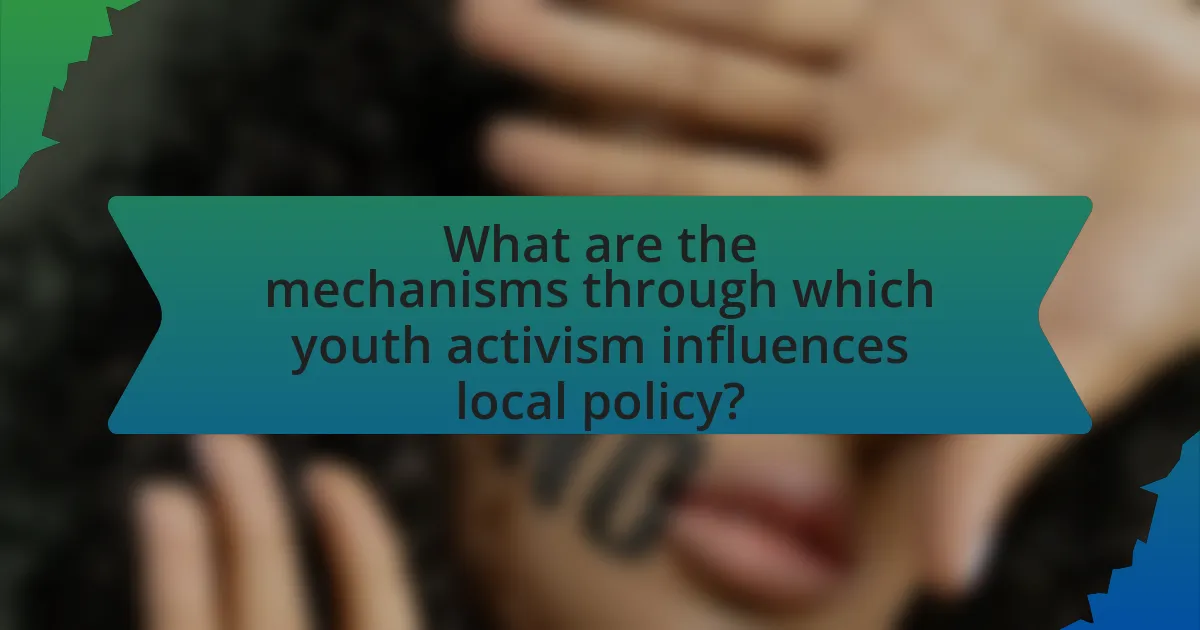
What are the mechanisms through which youth activism influences local policy?
Youth activism influences local policy through mechanisms such as grassroots mobilization, advocacy campaigns, and participation in local governance. Grassroots mobilization allows young activists to organize community events, rallies, and protests, effectively raising awareness and drawing public attention to specific issues, which can pressure local officials to respond. Advocacy campaigns utilize social media and traditional media to disseminate information and create narratives that resonate with the public and policymakers, thereby shaping public opinion and influencing decision-making processes. Additionally, youth participation in local governance, such as attending city council meetings or serving on advisory boards, provides direct channels for young people to voice their concerns and propose policy changes, leading to more inclusive and representative local governance. These mechanisms have been evidenced by movements like the March for Our Lives, which successfully advocated for gun control measures in various localities following the Parkland shooting in 2018.
How do youth-led initiatives shape policy discussions?
Youth-led initiatives shape policy discussions by actively engaging young people in advocacy and decision-making processes. These initiatives often bring fresh perspectives and innovative solutions to pressing social issues, which can influence policymakers to consider new approaches. For instance, the 2019 Global Climate Strike, led by youth activists like Greta Thunberg, mobilized millions worldwide and pressured governments to prioritize climate action in their agendas. Research from the Harvard Kennedy School indicates that youth activism can lead to significant shifts in public opinion, which in turn affects policy outcomes. By leveraging social media and grassroots organizing, youth-led initiatives effectively amplify their voices, making it difficult for policymakers to ignore their demands.
What strategies do youth activists use to advocate for change?
Youth activists employ various strategies to advocate for change, including grassroots organizing, social media campaigns, and coalition-building. Grassroots organizing allows them to mobilize community members, fostering local support for their causes. Social media campaigns amplify their messages, reaching wider audiences and engaging younger demographics effectively; for instance, the #FridaysForFuture movement, initiated by Greta Thunberg, utilized social media to inspire global climate strikes. Coalition-building with established organizations enhances their credibility and resources, enabling them to influence local policy changes more effectively. These strategies collectively empower youth activists to create significant impacts in their communities.
How do coalitions with other community groups enhance their impact?
Coalitions with other community groups enhance their impact by pooling resources, knowledge, and networks to address shared goals more effectively. This collaboration allows for a broader reach and increased visibility, which can amplify advocacy efforts. For instance, a study by the National Civic League found that coalitions can lead to a 30% increase in successful policy changes when diverse groups unite, as they bring varied perspectives and expertise that strengthen their collective voice.
What evidence exists to demonstrate the effectiveness of youth activism?
Youth activism has proven effective in influencing local policy changes, as evidenced by numerous case studies and documented outcomes. For instance, the March for Our Lives movement, initiated by students after the Parkland shooting in 2018, successfully advocated for gun control measures in several states, leading to the passage of laws such as Florida’s gun safety legislation. Additionally, the Sunrise Movement’s efforts to promote climate action have resulted in local governments adopting more aggressive sustainability policies, as seen in cities like San Francisco and New York. Research published in the Journal of Youth Studies highlights that youth-led campaigns often mobilize significant public support, which can sway policymakers to act in favor of the proposed changes. These examples illustrate that youth activism not only raises awareness but also directly contributes to tangible policy reforms.
What case studies illustrate successful policy changes driven by youth activism?
Case studies illustrating successful policy changes driven by youth activism include the March for Our Lives movement and the Sunrise Movement. The March for Our Lives, initiated by students from Stoneman Douglas High School after the 2018 shooting, successfully advocated for gun control measures, leading to the passage of laws in several states, including Florida’s gun safety legislation. The Sunrise Movement, focused on climate change, has influenced the Green New Deal’s introduction in Congress, showcasing the power of youth-led advocacy in shaping national policy. These examples demonstrate how organized youth activism can lead to tangible legislative changes.
How do local governments respond to youth-led movements?
Local governments often respond to youth-led movements by engaging in dialogue, implementing policy changes, and providing platforms for youth participation. For instance, many municipalities have established youth councils or advisory boards to incorporate young people’s perspectives into decision-making processes. This engagement is evident in cities like San Francisco, where the Youth Commission has influenced local policies on education and public safety. Additionally, local governments may organize forums or town hall meetings specifically aimed at addressing issues raised by youth activists, thereby fostering a collaborative environment. Research indicates that such interactions can lead to tangible policy outcomes, as seen in the increased funding for youth programs in response to advocacy efforts.
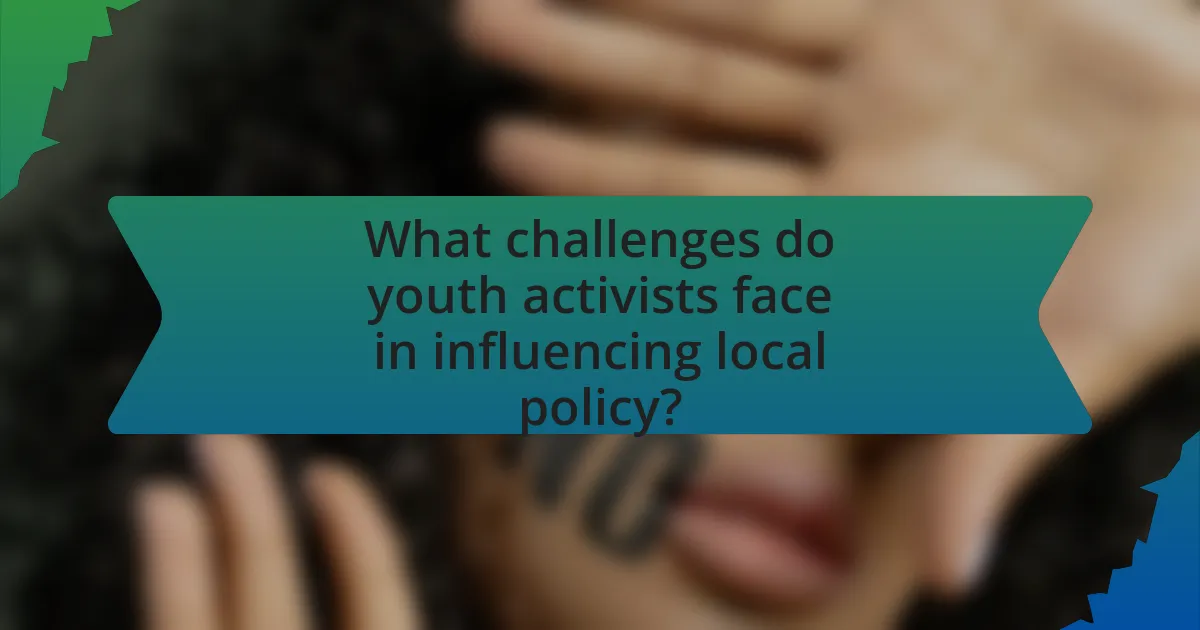
What challenges do youth activists face in influencing local policy?
Youth activists face significant challenges in influencing local policy, primarily due to a lack of access to decision-making processes and institutional barriers. Many local governments are not structured to engage youth voices effectively, leading to underrepresentation in policy discussions. Additionally, youth activists often encounter skepticism from established political figures who may dismiss their ideas as inexperienced or unrealistic. Research indicates that only 20% of local governments actively seek input from youth, which limits their ability to impact policy. Furthermore, youth activists frequently struggle with limited resources, including funding and organizational support, which hampers their capacity to mobilize and advocate effectively. These challenges collectively hinder the potential for meaningful youth engagement in local policy-making.
What barriers hinder youth participation in local governance?
Barriers that hinder youth participation in local governance include lack of access to information, limited political engagement opportunities, and societal perceptions that undervalue youth contributions. Research indicates that many young people feel uninformed about local governance processes, which diminishes their ability to engage effectively. Additionally, structural barriers such as age restrictions on certain political roles and a lack of mentorship programs further limit their involvement. A study by the United Nations Development Programme highlights that only 27% of youth feel their voices are heard in decision-making processes, underscoring the significant gap in youth representation and participation in local governance.
How do socioeconomic factors affect youth activism?
Socioeconomic factors significantly influence youth activism by shaping access to resources, education, and social networks. Youth from higher socioeconomic backgrounds often have greater access to education and financial resources, enabling them to engage more effectively in activism through organized movements and campaigns. For instance, a study by the Pew Research Center found that youth with higher family incomes are more likely to participate in civic activities, including protests and advocacy, compared to their lower-income peers. Conversely, youth from lower socioeconomic backgrounds may face barriers such as limited access to information, fewer opportunities for engagement, and economic pressures that can hinder their participation in activism. This disparity highlights how socioeconomic status can dictate the level of involvement and impact youth have in advocating for policy changes at the local level.
What legal or institutional obstacles do youth activists encounter?
Youth activists encounter various legal and institutional obstacles, including restrictive laws, lack of access to decision-making processes, and institutional resistance. Restrictive laws may include regulations that limit the right to assemble, protest, or express dissent, which can hinder youth-led movements. Additionally, youth activists often face barriers in accessing platforms for dialogue with policymakers, as many institutions prioritize established voices over younger demographics. Institutional resistance can manifest in the form of bureaucratic hurdles or dismissive attitudes from officials, which can undermine the effectiveness of youth activism. These obstacles collectively impede the ability of young activists to influence local policy changes effectively.
How can youth activists overcome these challenges?
Youth activists can overcome challenges by building coalitions with established organizations to gain resources and support. Collaborating with experienced groups allows youth activists to access mentorship, funding, and a broader platform for their initiatives. For instance, the Sunrise Movement successfully partnered with various environmental organizations to amplify their message and influence local policy on climate change. This strategy not only enhances their credibility but also increases their impact on policy changes.
What resources are available to support youth activism?
Various resources are available to support youth activism, including nonprofit organizations, online platforms, and educational programs. Nonprofit organizations such as the Sierra Club and Amnesty International provide training, funding, and networking opportunities for young activists. Online platforms like Change.org and social media channels facilitate the mobilization of youth around specific causes, allowing them to share their messages widely. Educational programs, including workshops and seminars offered by institutions like the National Youth Leadership Council, equip young people with skills in advocacy, public speaking, and community organizing. These resources collectively empower youth to engage effectively in activism and influence local policy changes.
How can mentorship and education empower young activists?
Mentorship and education empower young activists by providing them with essential skills, knowledge, and networks necessary for effective advocacy. Through mentorship, experienced activists can share strategies, insights, and real-world experiences that enhance the capabilities of youth, enabling them to navigate complex political landscapes. Education equips young activists with critical thinking skills and an understanding of social issues, which fosters informed decision-making and effective communication. Research indicates that youth-led initiatives, supported by mentorship and education, have successfully influenced local policies, such as the 2018 youth climate strikes that prompted legislative discussions on climate action in various countries. This combination of guidance and knowledge not only amplifies their voices but also increases their impact on policy changes.
What best practices can enhance the influence of youth activism on local policy changes?
Engaging youth activism effectively can enhance its influence on local policy changes through strategic coalition-building, targeted communication, and leveraging digital platforms. Coalition-building allows youth activists to unite with established organizations, increasing their credibility and reach; for instance, partnerships with local NGOs can amplify their voices and resources. Targeted communication, including clear messaging tailored to specific audiences, ensures that the concerns of youth resonate with policymakers; studies show that concise, data-driven arguments are more persuasive in policy discussions. Additionally, leveraging digital platforms enables youth activists to mobilize support quickly and widely, as seen in movements like the March for Our Lives, which utilized social media to organize and influence gun control policies. These best practices collectively create a robust framework for youth activism to effect meaningful local policy changes.
How can youth activists effectively communicate their messages?
Youth activists can effectively communicate their messages by utilizing social media platforms to reach a broader audience and engage in direct dialogue. Research indicates that 90% of young people use social media, making it a powerful tool for disseminating information and mobilizing support. By crafting clear, concise messages and using visual content, such as infographics and videos, youth activists can capture attention and convey their points more effectively. Additionally, collaborating with established organizations can amplify their reach and lend credibility to their initiatives.
What role does community engagement play in successful activism?
Community engagement is crucial for successful activism as it fosters collective action and amplifies voices within a community. Engaged communities are more likely to mobilize resources, share information, and build networks that enhance the effectiveness of activism efforts. For instance, research by the Stanford Social Innovation Review indicates that grassroots movements with strong community ties can achieve policy changes more effectively than those lacking such connections. This demonstrates that community engagement not only strengthens the legitimacy of activist initiatives but also increases their impact on local policy changes.
